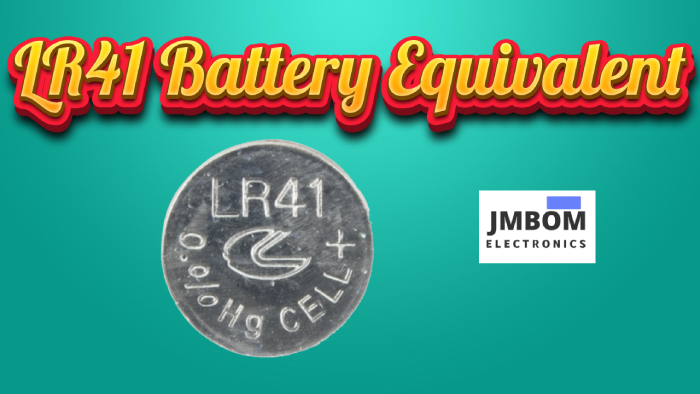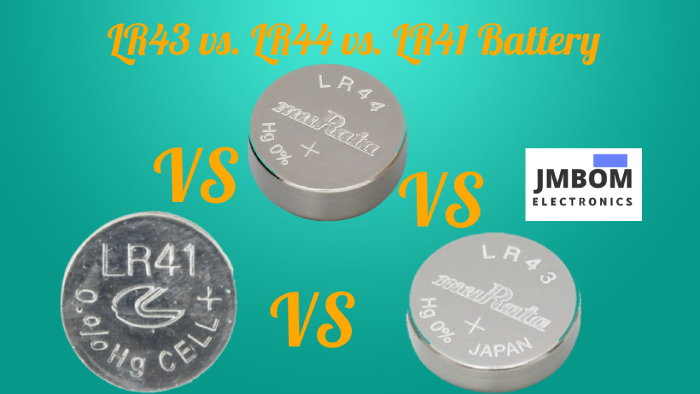

LR41 Battery Equivalent:Everything You Need to Know
Catalog
What is an LR41 Battery?LR41 Battery SpecificationsWhere Can I Find LR41 Batteries?LR41 Battery ApplicationsAdvantages of Using LR41 BatteryLR41 Battery EquivalentsLR43 vs. LR44 vs. LR41 Battery ComparisonLR43 vs. LR44 vs. LR41 Battery FeaturesLR43 vs. LR44 vs. LR41 Battery EquivalentsLR44 Battery: A Viable Alternative to LR41 BatteryAdvantages of Using LR44 BatteryLR43 Battery: Not a Direct Alternative to LR41 BatteryAdvantages of Using LR43 BatteryConclusion of LR41 Battery EquivalentsRelated ArticlesWhat is an LR41 Battery?
The LR41 battery is a small alkaline button cell. It is about 7.9 mm in diameter and 3.6 mm in height, with a nominal voltage of 1.5 volts. Typically, it has a capacity of 25 to 30 milliampere-hours (mAh). LR41 batteries are commonly used in low-power devices such as watches, calculators, remote controls, digital thermometers, medical equipment, toys, laser pointers, and small LED flashlights.

LR41 Battery Equivalen
LR41 Battery Specifications
| Specification of LR41 Battery | Values |
| Type | Alkaline Button Cell |
| Model | LR41 |
| Nominal Voltage | 1.5 Volts |
| Capacity | 25–30 mAh |
| Diameter | 7.9 mm |
| Height | 3.6 mm |
| Common Applications | Watches, Calculators, Remote Controls, Digital Thermometers, Medical Instruments, Toys, Laser Pointers, Small LED Flashlights |
| Shelf Life | Seven Years |
For small electronic devices, the LR41 battery is a reliable and modest power source. Its compact size and efficient power output make it an ideal choice for low-power applications, ensuring long-lasting performance in everyday devices.
Where Can I Find LR41 Batteries?
LR41 batteries are widely used and highly sought after. As a result, numerous manufacturers produce them, and many retailers offer these batteries for sale. However, it's crucial to recognize that not all LR41 batteries are of the same quality, and not all retailers prioritize quality equally. To ensure you get reliable and genuine batteries, it's best to buy from a reputable retailer that specializes in high-quality brands.
JMBom.com has been a trusted online battery retailer since 2008, offering an extensive range of batteries, including the LR41, from well-known manufacturers around the world. If you're looking for all your battery needs, consider JMBom.com as your go-to battery expert!
LR41 Battery Applications
The LR41 battery is widely used in various small electronic devices due to its small size and reliability. Here are some key applications:
Watches and Clocks: LR41 batteries are commonly used to power timekeeping devices like wristwatches and clocks.
Calculators: Many handheld calculators rely on LR41 batteries for consistent and accurate performance.
Medical Devices: Devices such as digital thermometers, diabetes meters, and hearing aids require reliable and long-lasting power, which LR41 batteries provide.
Remote Controls: LR41 batteries are frequently used in remote controls for garage doors, car keys, and other small electronic devices.
Toys: The small size and steady voltage output of LR41 batteries make them suitable for a variety of electronic toys.
Flashlights: LR41 batteries are sometimes used in small flashlights or keychain lights for emergency use.
Laser Pointers: Many laser pointers use LR41 batteries due to their compact form factor.
Security Systems: LR41 batteries serve as a backup power source in some security system panels.
Overall, the LR41 battery is a popular choice across many industries because it is versatile and well-suited for applications that require a small but reliable power source.
Advantages of Using LR41 Battery
The LR41 battery is a popular choice for powering small electronic devices, and it offers several benefits. Here are the main advantages:
- Compact Size: Measuring 7.9 mm in diameter and 3.6 mm in height, the LR41 battery fits perfectly into space-limited devices such as calculators and watches.
- Stable Voltage Output: With a nominal voltage of 1.5 volts, the LR41 battery ensures consistent performance in various applications, making it ideal for precision instruments and delicate devices.
- Good Capacity: The LR41 battery can power low-drain devices for extended periods, with a capacity of up to 32 milliampere-hours.
- Wide Availability: LR41 batteries are readily available in many electronics stores and online marketplaces, making it easy to find replacements.
- Cost-Effectiveness: Compared to other battery types like lithium or silver oxide, LR41 batteries are more affordable, providing a reliable power source without breaking the bank.
- Alkaline Chemistry: The LR41 is a well-known alkaline battery that offers good performance at a reasonable price, appealing to customers looking for dependable options.
- Long Shelf Life: When stored properly, LR41 batteries have a shelf life of 2 to 5 years, making them suitable for infrequently used electronics.
- Environmental Impact: Alkaline batteries like the LR41 generally have a lower environmental impact compared to heavy metal-containing batteries such as those with cadmium or mercury. However, recycling and proper disposal are still important.
- Thanks to these benefits, the LR41 battery is a versatile and sensible choice for a variety of compact electronic applications.
LR41 Battery Equivalents
- While LR41 batteries are widely available and commonly used, there are some alternatives you might consider depending on your specific needs:
- SR41 Battery: SR41 batteries are a good alternative to LR41 batteries due to their similar size and voltage characteristics. Although they may be slightly more expensive, they are often interchangeable with LR41 batteries.
- LR44 Battery: If your device allows for a slightly larger battery, the LR44 (also known as AG13 or A76) can be used as a substitute. These batteries have a larger size than LR41 cells, which can provide longer runtime.
- Silver Oxide vs. Alkaline: The SR41 battery uses silver oxide chemistry, while the LR41 battery uses alkaline chemistry. Silver oxide batteries offer a more stable voltage output, which is beneficial for applications requiring a consistent power supply.
- Examine Energy Demands: When choosing a substitute, consider your device's energy requirements. Some alternatives may offer longer runtime, but their physical size might not be compatible with your device's design.
- The LR44 battery is an excellent alternative to the LR41 battery. Let's take a closer look at this option.
LR43 vs. LR44 vs. LR41 Battery Comparison

LR43 vs. LR44 vs. LR41 Battery
Here is a detailed comparison table for the LR43, LR44, and LR41 batteries. These are common alkaline button cell batteries, each with different sizes and capacities:
| Specification | LR43 Battery | LR44 Battery | LR41 Battery |
| Chemistry | Alkaline | Alkaline | Alkaline |
| Nominal Voltage | 1.5V | 1.5V | 1.5V |
| Diameter | 11.6 mm | 11.6 mm | 7.9 mm |
| Height | 4.2 mm | 5.4 mm | 3.6 mm |
| Capacity | ~110 mAh | ~150-160 mAh | ~35-40 mAh |
| Typical Use Cases | Watches, Calculators | Toys, Medical Devices, Watches | Small electronics, Laser pointers |
| Common Equivalents | AG12, 386A, V12GA, RW42 | AG13, A76, 357, L1154 | AG3, 192, 384, 392 |
| Weight | ~1.85 g | ~2.1 g | ~0.6 g |
| Operating Temperature | -10°C to 50°C | -10°C to 50°C | -10°C to 50°C |
LR43 vs. LR44 vs. LR41 Battery Features
LR43 vs. LR44 vs. LR41 Battery
LR43 Battery Features

LR43 Battery Features
- Cost-Effective: The LR43 battery uses manganese dioxide as the cathode material, offering great value for money.
- Stable Performance: It provides a steady voltage output, making it suitable for various applications, including those with high-drain pulses.
- Leak-Resistant: Its unique sealing design enhances leak resistance, ensuring long-term reliability.
- Environmentally Friendly: The LR43 battery is RoHS compliant, containing no hazardous materials like lead, cadmium, or mercury.
LR44 Battery Features

LR44 Battery Features
- High-Drain Capability: It can maintain high voltage and large currents for extended periods, about three times longer than conventional batteries.
- Safety Features: It uses proprietary mercury-free technology, ensuring reliability and safety, especially for medical applications.
- Proven Quality: Manufactured with over 40 years of experience, entirely in Japan, ensuring unwavering reliability and quality.
LR41 Battery Features

LR41 Battery Features
- The LR41 battery has a nominal capacity of 25–32 mAh and a nominal voltage of 1.5 volts. Some brands may claim higher capacities, but these batteries are typically used at very low currents, and their actual capacity usually falls within the 25–32 mAh range.
LR43 vs. LR44 vs. LR41 Battery Equivalents
LR43 Battery Equivalents
- The LR43 battery is a small alkaline button cell, widely used in watches, calculators, and small devices. It has several equivalent batteries with similar sizes, voltages, and capacities. Here are the common LR43 equivalents:
AG12 Battery: The AG12 is the most common equivalent to the LR43. It uses alkaline chemistry and has the same 1.5V nominal voltage. It can be used interchangeably with the LR43 in most devices.
86 Battery: The 86 Battery is another name for the LR43 equivalent, with the same size and voltage. Though less commonly used, it refers to the same type of battery.
301 / 386 Battery: These are silver oxide equivalents to the LR43. Silver oxide batteries usually offer a more stable voltage and longer lifespan compared to alkaline batteries. The 301 and 386 are similar in size to the LR43 and can be used as compatible replacements.
SR43 Battery: The SR43 is the silver oxide version of the LR43. Like other silver oxide batteries, the SR43 provides consistent voltage over time, making it ideal for devices that need stable power. The SR43W and SR43SW indicate different discharge rates (W for high-drain devices, SW for low-drain devices).
GP43 Battery: The GP43 is another equivalent to the LR43, made by GP Batteries. It's an alkaline button cell battery and can be used interchangeably with the LR43 in most devices.
L1142 Battery: The L1142 is another name for the LR43 battery, used by some manufacturers. It has the same size, voltage, and chemical composition as the LR43.
LR44 Battery Equivalents
Alkaline-type batteries include the LR44. Alternatives are A76, AG13, G13, LR1154, L1154, and 154. Alkaline LR44 batteries can also be swapped for silver-oxide ones; substitutes include SR44, SR44SW, SR44W, SB-B9, 303, and 357.
LR41 Battery Equivalents
LR41 batteries can be directly replaced with 192, 92A, LR736, and AG3 batteries. However, silver oxide batteries like 384, SR41, and 392, despite having the same size and dimensions as LR41 batteries, are not perfect replicas or direct replacements. Their distinct chemical compositions result in variable functionality in various applications. These substitutes are not the same even if they have the same dimensions as LR41 batteries.
LR44 Battery: A Viable Alternative to LR41 Battery
When searching for alternatives to the LR41 battery, the LR44 is a well-known substitute. The LR44, often referred to as AG13 or A76, is similar to the LR41 in some aspects but also offers some benefits. Here, we examine the key characteristics, compatibility, and factors to consider when switching from LR41 to LR44 batteries.
Size and Dimensions:
The most noticeable difference between the LR41 and LR44 batteries is their size. The LR41 is more compact, with a height of 3.6 mm and a diameter of 7.9 mm.
In contrast, the LR44 is taller at 5.4 mm and has a larger diameter of about 11.6 mm. This larger size gives it a longer lifespan and higher energy capacity, making it a more potent choice in some applications.
Interchangeability and Compatibility:
Although they are not the same size, LR44 batteries are often used as substitutes for LR41 cells in devices that can accommodate the larger size. An LR44 battery may work with many devices designed for LR41 batteries without modification.
However, it's crucial to ensure that the LR44's larger size does not affect the device's usability or safety, especially if the battery compartment is specifically designed for the smaller LR41. To prevent any issues with the device's functionality, ensure a proper fit.
Conclusion:
While the LR44 battery has more capacity and power than the LR41, it should only be used in devices that can accept its larger size due to its bigger dimensions.
Advantages of Using LR44 Battery
- Extended Runtime: LR44 batteries have a higher energy capacity than LR41 batteries due to their larger size. This makes LR44 batteries particularly well-suited for devices that require more energy, offering a longer runtime.
- Voltage Stability: Like LR41 batteries, LR44 batteries provide consistent voltage output throughout their lifespan. This is especially useful for electronics and medical equipment that require steady, reliable power.
- Cost-Effectiveness: LR44 batteries are inexpensive and widely available. They are an attractive option for those looking for an affordable replacement for the LR41 battery.
LR43 Battery: Not a Direct Alternative to LR41 Battery
- The LR43 battery is not a direct equivalent or viable alternative to the LR41 battery. While they are both alkaline button cell batteries, there are significant differences in size, voltage, and capacity that make them incompatible for direct substitution.
Key Differences Between LR43 and LR41 Battery
- Size: The LR43 battery has a diameter of 11.6 mm and a height of 4.2 mm, while the LR41 battery is much smaller, with a diameter of 7.9 mm and a height of 3.6 mm.
- Voltage: Both the LR43 and LR41 batteries have a nominal voltage of 1.5V.
- Capacity: The LR43 battery has a typical capacity of 110mAh, significantly higher than the 25-32mAh capacity of the LR41 battery.
- Weight: The LR43 battery weighs 1.6g, while the LR41 battery weighs only 0.57g.
Alternatives to LR41 Battery
Direct replacements for the LR41 battery include 192, 92A, LR736, and AG3. However, it's important to note that while the 384, SR41, and 392 silver oxide batteries share the same size and dimensions as the LR41, they are not exact counterparts or direct substitutes due to their different chemical compositions.
Advantages of Using LR43 Battery
The LR43 battery offers several benefits that make it a superior option for a range of applications:
- High Capacity and Energy Density: The LR43 battery is known for its large capacity—approximately 110mAh—which allows it to power electronics for extended periods. Its high energy density means devices can operate efficiently without frequent battery changes.
- Durability and Reliability: LR43 batteries are designed for long-term, consistent performance. Their excellent leak resistance enhances their reliability in sensitive electronics. Durability is crucial in applications like security systems and medical devices, where battery failure can have severe consequences.
- Stable Voltage Output: The ability to maintain a stable voltage output throughout their discharge cycle is essential for applications that require constant power levels. This feature ensures that electronic devices and tools operate as intended, without interruption.
- Cost-Effectiveness: LR43 batteries are widely available and reasonably priced, making them a cost-effective choice for consumers. Their extended lifespan also enhances their overall value by reducing the need for frequent replacements over time.
- Versatile Applications: The LR43 battery is compatible with numerous devices, including watches, calculators, remote controls, and electronic toys. Its versatility makes it a sensible option for a variety of everyday uses.
- Environmental Compliance: LR43 batteries are produced in compliance with environmental standards, being free of lead, cadmium, and mercury. Their compliance makes them a safer choice for both people and the environment.
Conclusion of LR41 Battery Equivalents
The LR41 battery, a versatile and small button cell battery, is used in many small electronic devices. Although it has a specific classification, there are several similar and alternative batteries that work well in various situations.
In conclusion, while the LR41 has its own unique classification, there are numerous similar and substitute button cell batteries available that can power small electronic devices when needed. When choosing a replacement, careful consideration of voltage, chemistry, and size is advised.
Related Articles
LR41 Battery Equivalent-A Complete Guide
CR1616 Battery Equivalent:What You Need to Know
Subscribe to JMBom Electronics !













